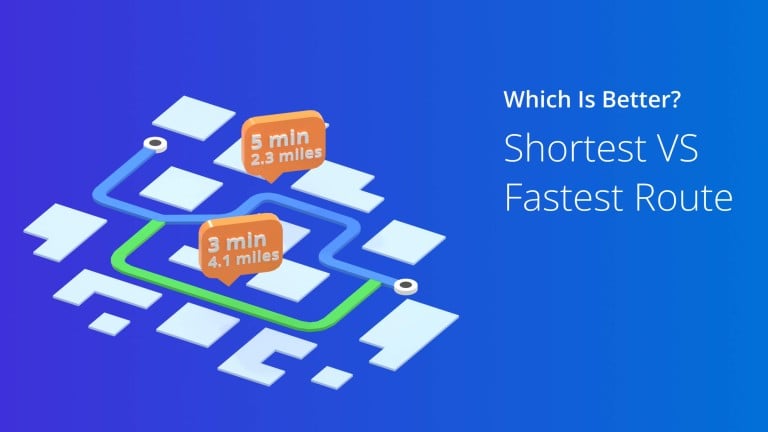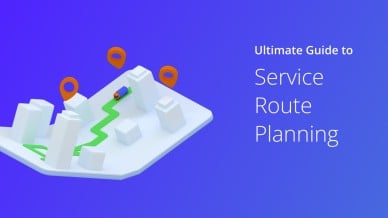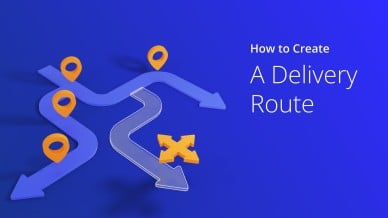All drivers need safe and fast routes.
Fast routes don’t mean unsafe routes, and they don’t mean driving 100 miles per hour.
When we talk about finding the best fast routes to multiple locations, we mean the automated usage of computer programs to quickly identify and determine the correct streets to travel throughout various times of the day for your benefit.
Distance-based routing is dead because the distance between major cities can be very short, and the travel time can last for hours.
Think Manhattan to Brooklyn, Manhattan to Newark, or New Haven to JFK airport. These types of trips can take up to 3 hours, based on traffic conditions, while being in extremely close proximity.
The fastest routes may involve traveling back roads, delaying the start of a trip by 30 minutes or an hour, or leaving 1 or 2 hours earlier. The dynamic nature of the routing game is what makes it both complex and exciting.
Ensuring efficient field operations is a top issue for most field service businesses. This is because even small reductions in transportation costs or driving time can add significant savings for the company. With this in mind, many field service businesses use delivery route optimization software to help their drivers find accurate driving directions from one place to another.
Yet, a sales rep might prefer a route with less driving time to spend more time with customers. In contrast, a delivery company that transports chemicals may choose a route that uses highways and avoids high-density city areas.
The “best route” means different things to different people and businesses. For most, the best route would be the shortest one. For some, though, it may be the fastest path. And some may prefer a trip that uses highways or avoids tolls and tunnels. To each their own!
Besides, the fastest or shortest route may not always be the most efficient route. For instance, the quickest route might have many left turns, and the shortest mileage route may drive through heavy traffic. In both these route options, your fuel consumption will go up significantly.
Also, what if the fastest route is three minutes faster but several miles longer? Is it still an efficient one?
What if the shortest path allows you to drive 5 miles less but makes you go through two tolls? Is it an efficient one?
Table of Contents
Shortest or Fastest? Which One Should You Choose?
When planning a route, how do you know which type of route is best?
Your first option is to choose the fastest or shortest route.
Your second option is to choose a route that considers all the factors, including weather, road conditions, traffic congestion, customer delivery time preferences, vehicle capacity constraints, left turns, tolls, and tunnels.
Many successful field service and delivery businesses choose the second option. They realize that a common misconception is that the best routes are either the shortest or fastest when, in reality, planning routes is much more complicated.
Let’s look at real-life examples to understand the importance of route planning and why you should consider all the factors when planning and not just choose the shortest or fastest routes.
Example 1: Delivery Service Businesses
Route Planning Goals: Avoid left turns, save fuel, and ensure driver safety.
Many delivery service businesses, or just those who deliver packages with their car, plan their routes while keeping fuel consumption and driver safety in mind.
For instance, rather than taking the shortest mileage route, UPS prefers a route with the least amount of left turns.
There are two reasons for this preference: safety and efficiency.
Left turns are considered more dangerous because the driver must navigate oncoming traffic, increasing the risk of accidents.
Also, avoiding left turns is considered fuel-friendly as the driver does not need to wait long at traffic lights to turn.
Want To See For Yourself How Route4Me Can Help Plan Well-optimized Routes?

Example 2: Crowdsourced Delivery Businesses
Route Planning Goals: Timely deliveries and adhering to customers’ delivery time windows.
Crowdsourcing is one of the latest trends in the delivery industry, fueled by customers expecting same-day and two-hour deliveries. Since this model is based on speedy and convenient customer service, adhering to specific time windows is necessary.
Different types of customers, promised delivery times, and the types of packages being delivered and picked up are some of the many factors that dispatchers consider when planning the best route for such businesses. And the shortest or fastest routes may not work because they may not accommodate the specific time windows requested by some customers.
So, the best route is the one that allows the company to serve all its customers as per the specific time slots, reduces travel time, is fuel-efficient, and provides sufficient breaks for the drivers.
Planning the best route while considering all those factors will take an enormous amount of time if you do it manually.
However, a multi-stop route planner app can consider all those factors and create an optimized route for your drivers in less than 30 seconds.
Example 3: In-Home Service Businesses Need to Route Fast
Route Planning Goals: Consistent service that earns customer loyalty and adheres to customers’ time windows.
The biggest challenge of an in-home service business is consistent service, which means providing customer service at the promised time and preferably with the same employee.
Unfortunately, the preference to assign the same rep or driver for a particular customer while honoring the specific time windows often conflicts with the shortest or fastest route.
Routing fast is more than allowing drivers to get to customers efficiently. It’s also about saving route planning staff and dispatchers immeasurable amounts of time over many years of repetitive day-to-day operations work.
Yet, in-home service businesses should prioritize customer satisfaction over quicker routes. So, they should plan routes by providing a “time window” and ensure the same employee visits the same customer at the committed time.
Multi-Stop Route Planner App

Frequently Asked Questions (FAQs) about the Difference Between the Shortest Route and the Fastest Route
What is a shortest route?
Is following the shortest route always better and safer?
Why is the fastest route more miles?
Final Thoughts about Shortest vs. Fastest Route
Delivery service businesses are more concerned with using an efficient route, while crowdsourced companies that survive on speedy customer service are looking for routes that are both efficient and accommodate the customers’ needs.
Whichever business category you fall in, finding the right route type will never be a “one-and-done” process. It will always be an iterative process, and you’ll find yourself balancing customer needs, transportation costs, and travel time.
Want To See For Yourself How Route4Me Can Help Plan Well-optimized Routes?












